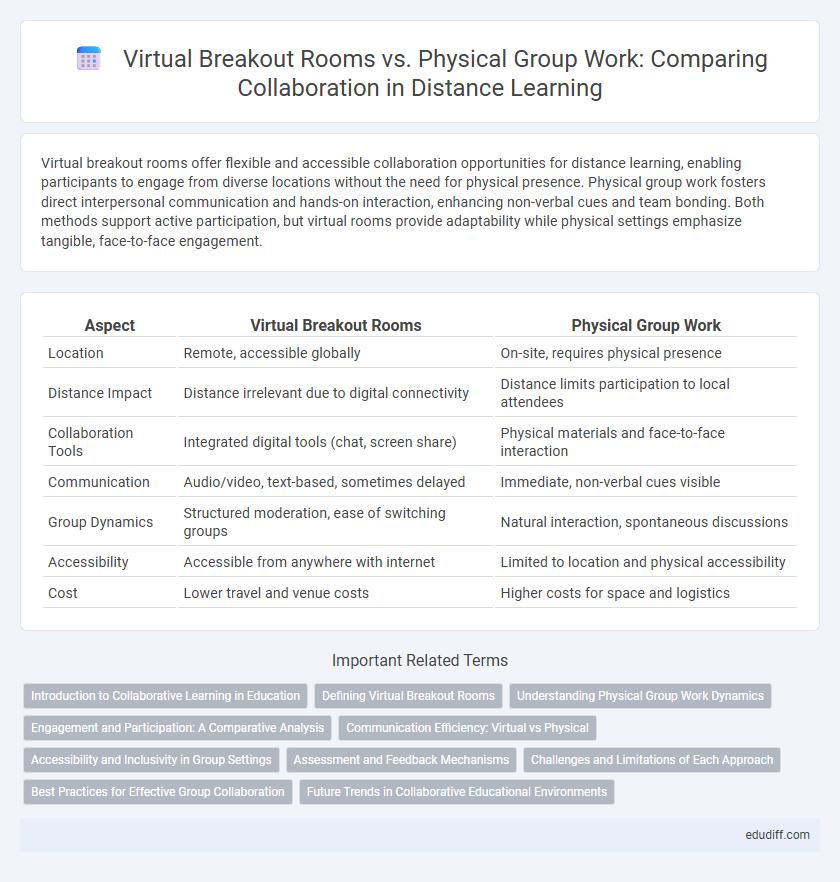Virtual breakout rooms offer flexible and accessible collaboration opportunities for distance learning, enabling participants to engage from diverse locations without the need for physical presence. Physical group work fosters direct interpersonal communication and hands-on interaction, enhancing non-verbal cues and team bonding. Both methods support active participation, but virtual rooms provide adaptability while physical settings emphasize tangible, face-to-face engagement.
Table of Comparison
| Aspect | Virtual Breakout Rooms | Physical Group Work |
|---|---|---|
| Location | Remote, accessible globally | On-site, requires physical presence |
| Distance Impact | Distance irrelevant due to digital connectivity | Distance limits participation to local attendees |
| Collaboration Tools | Integrated digital tools (chat, screen share) | Physical materials and face-to-face interaction |
| Communication | Audio/video, text-based, sometimes delayed | Immediate, non-verbal cues visible |
| Group Dynamics | Structured moderation, ease of switching groups | Natural interaction, spontaneous discussions |
| Accessibility | Accessible from anywhere with internet | Limited to location and physical accessibility |
| Cost | Lower travel and venue costs | Higher costs for space and logistics |
Introduction to Collaborative Learning in Education
Virtual breakout rooms enable real-time collaboration across geographical distances, enhancing accessibility and inclusivity in collaborative learning environments. Physical group work fosters face-to-face interaction, promoting nonverbal communication cues essential for building rapport and effective teamwork. Integrating virtual breakout rooms within educational platforms supports dynamic group discussions while overcoming the constraints of physical distance in collaborative learning contexts.
Defining Virtual Breakout Rooms
Virtual breakout rooms are digitally designated spaces within video conferencing platforms that allow participants to engage in smaller, focused group discussions remotely. These virtual environments replicate the dynamics of physical group work by enabling real-time collaboration, file sharing, and interactive communication. They optimize distance learning and remote teamwork by fostering engagement and facilitating effective subgroup interactions despite geographical separation.
Understanding Physical Group Work Dynamics
Physical group work dynamics involve face-to-face interaction that enhances nonverbal communication cues such as body language and eye contact, promoting immediate feedback and stronger social bonds. These dynamics facilitate spontaneous collaboration and adaptability, which can be more challenging to replicate in virtual breakout rooms due to technological delays and limited sensory input. Understanding these physical interactions is crucial for optimizing teamwork effectiveness in both remote and in-person settings.
Engagement and Participation: A Comparative Analysis
Virtual breakout rooms leverage digital tools to facilitate real-time interaction, often increasing accessibility and ease of participation across diverse locations. Physical group work encourages direct, face-to-face communication, which can enhance non-verbal cues and spontaneous collaboration, leading to deeper engagement. Studies reveal mixed results on participation rates, with virtual environments promoting inclusivity while physical settings foster stronger interpersonal connections.
Communication Efficiency: Virtual vs Physical
Virtual breakout rooms enable real-time communication with integrated digital tools such as chat, polls, and screen sharing, enhancing interaction efficiency despite physical separation. Physical group work benefits from spontaneous verbal and non-verbal cues, supporting quicker conflict resolution and nuanced understanding. Both modalities differ in communication speed and feedback depth, impacting collaborative outcomes in distance and co-located settings.
Accessibility and Inclusivity in Group Settings
Virtual breakout rooms enhance accessibility by enabling remote participants to join discussions without geographical constraints, accommodating diverse schedules and mobility limitations. Physical group work may inadvertently exclude individuals facing transportation challenges or health-related barriers, reducing overall inclusivity. Digital platforms facilitate customizable environments that support various learning styles and accessibility needs, promoting equitable participation in group settings.
Assessment and Feedback Mechanisms
Virtual breakout rooms enable real-time digital assessment tools such as quizzes and polls, providing immediate, data-driven feedback to students. Physical group work facilitates direct observational assessment and nuanced, face-to-face feedback, enhancing interpersonal skill evaluation. Both methods offer distinct advantages in monitoring student progress and tailoring feedback for improved learning outcomes.
Challenges and Limitations of Each Approach
Virtual breakout rooms face challenges such as limited non-verbal communication cues, reliance on stable internet connectivity, and potential technological glitches that hinder seamless interaction. Physical group work often struggles with logistical constraints like space availability, scheduling conflicts, and potential social dynamics that may inhibit participation. Both approaches require adaptive strategies to effectively address engagement, collaboration, and communication barriers intrinsic to their respective environments.
Best Practices for Effective Group Collaboration
Virtual breakout rooms leverage digital tools such as video conferencing platforms with real-time chat, screen sharing, and collaborative whiteboards to enhance group collaboration across distances. Physical group work benefits from face-to-face interaction, immediate non-verbal cues, and spontaneous brainstorming, fostering deeper engagement. Best practices for effective collaboration include setting clear objectives, establishing roles, and using technology to facilitate communication and accountability in virtual settings while encouraging active participation and open dialogue in physical environments.
Future Trends in Collaborative Educational Environments
Virtual breakout rooms enable seamless collaboration across geographic distances, leveraging real-time video and interactive tools to enhance student engagement beyond physical constraints. Emerging technologies such as AI-driven facilitation and augmented reality are expected to further enrich virtual group dynamics, offering personalized learning paths and immersive experiences. Physical group work retains its value for tactile, spontaneous interaction, but hybrid models combining digital and in-person collaboration are poised to dominate future educational environments, optimizing flexibility and inclusivity.
Virtual breakout rooms vs Physical group work Infographic

 edudiff.com
edudiff.com